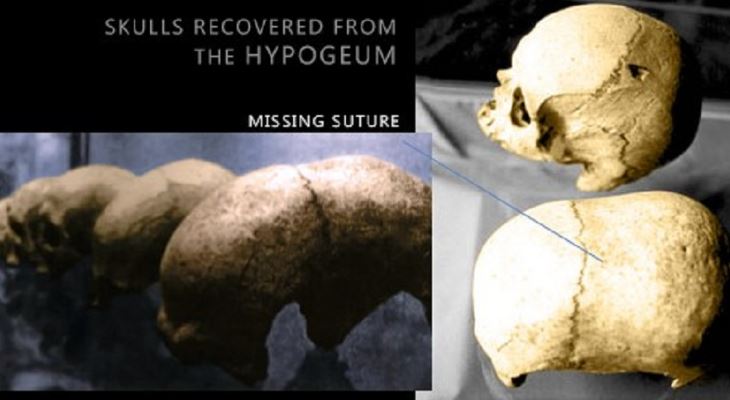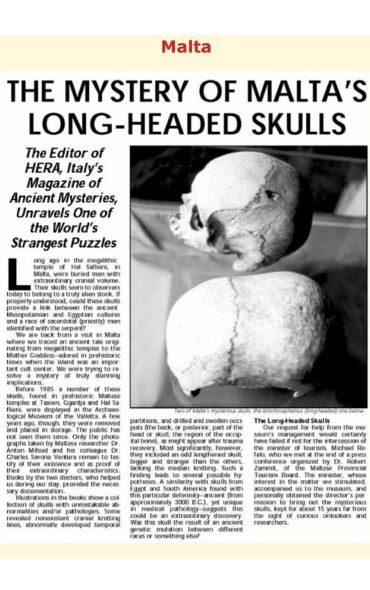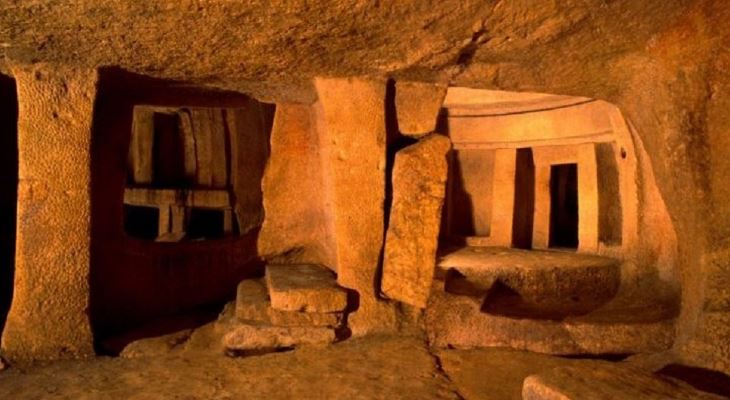The underground necropolis of Malta has its secrets.

In the oldest underground temple and necropolis in the world - the Hal Saflieni Hypogeum, here in Malta - a collection of skulls was discovered that show peculiar abnormalities and/or pathologies: sometimes inexistent cranial knitting lines, abnormally developed temporal partitions; evidence of drilling and swelling at the back of the head, possibly from recovered traumas; and, strangest of all, a lengthened skull lacking a fossa median, the join that runs along the top of the skull. The reason for these abnormalities have been shrouded in mystery.
Until 1985, the unearthed skulls were on display at the National Museum of Archaeology. Strangely, Heritage Malta, the authority responsible for Malta’s prehistoric heritage, removed them from public view around 30 years ago, and, since then, they have only been available to researchers by special permission.

Heritage Malta outright dismisses some theories which have been floating about, related to ‘serpent priests’ or ‘alien skulls’. Fair enough, the theories - despite the curious evidence - only exist within the realm of speculation. But, in 2017, Heritage Malta set out to completely ‘bust the myth’ regarding the elongated skulls at the refurbished Visitors Centre at the Hal Saflieni Hypogeum. Why so much effort to dissuade anyone from believing that anything extraordinary had been found down there?
Photos and books by Dr Anton Mifsud and his colleague Dr Charles Savona Ventura, who first investigated the skulls, testify to their existence and abnormality. Vittorio Di Cesare and Adriano Forgione of HERA magazine, Rome, Italy were the only non-officials able to obtain permission to investigate the skulls. They published a very thorough article regarding their findings and it would seem that they were very impressed.

Most interesting to them was the skullcap with the lengthened posterior. Their research confirmed that the cranium was naturally long and not as a result of bandaging or boards, as was customary in ancient South American civilizations. And, they couldn't find evidence of median knitting, technically named sagitta, which is considered ‘impossible’ by medics and anatomists. Di Cesare and Forgione also did not discount that this find was particular to the Hal Saflieni Hypogeum. They went on, in their article, to draw parallels and conclusions related to the Egyptian culture and so-called 'serpent priests'.
Meanwhile, Ms Rodriguez Aguilera was running for office in Miami as a Republican when an interview of her alien abduction as a child resurfaced. Therein she claimed the aliens had told her that “there are 30,000 skulls - different from those of human beings - in a cave on the Mediterranean island of Malta.” Is that so?

The skulls, dating back to 3000-2500 BC, were first discovered in 1902. By the 1920s, the National Geographic magazine (January to June, 1920 VOLUME XXXVII) reported that the first inhabitants of Malta were a race with elongated skulls:
“From an examination of the skeletons of the polished-stone age, it appears that the early inhabitants of Malta were a race of long-skulled people of lower medium height, akin to the early people of Egypt, who spread westward along the north coast of Africa, whence some went to Malta and Sicily and others to Sardinia and Spain.”
In fact, despite the attempts of Heritage Malta to water down the finding, the story of the elongated skulls of Malta has been reported far and wide. These include the following 4-minute Mystery History documentary.
Neanderthal, Cro-Magnon, Denisovans, Modern Man … are the ‘long heads’ a hybrid species? A different species? Aliens? What is certain is that they were real and apparently revered as gods such that modern human beings purposefully mutilated themselves to look like them. Yet, instead of capitalising on this find, Malta hides away the ‘long-headed’ skulls and dismisses any notion that they could bear any special importance. Just…odd!
So while Heritage Malta shrugs off the extraordinary find in the depths of the earth at the Hypogeum, Belgian author Philip Coppens, who focuses on fringe science and alternative history, and others around the world, continue to raise interesting questions. Such as:
- Why were the reports of Emmanuel Magri, the first official excavator of the site, never published? Why, upon his death in 1907, had all of his notebooks on the excavation disappeared?
- Why, when it was originally reported that the bones of 33,000 people were found, was this figure later changed to 7,000, and then reduced again to a mere 100?
- Why were the elongated skulls removed from public view in 1985? Why are they now only available to researchers? Why are only six of the original eleven still at the museum? Where are the others?
- Why was the Hypogeum of Santa Lucia sealed off and never excavated since it was discovered in 1973?
- Why was the Brockdorff Circle - a hypogeum in Gozo - buried and forgotten after it was discovered in 1820, only to be rediscovered in 1964? And why did it take until 1987 and 1994 to properly excavate it? What might have gone missing since the 19th Century?
- Could there be any truth to the tales of strange giant humanoids dwelling in hidden caverns below the Hal Saflieni Hypogeum? Is there any truth to the tales of disappearing children? What could be the reason for the cover-ups?
What do you think?